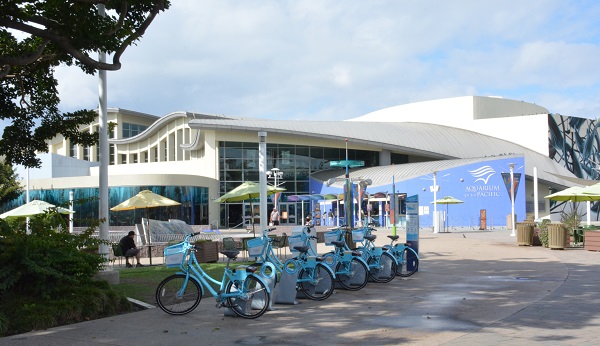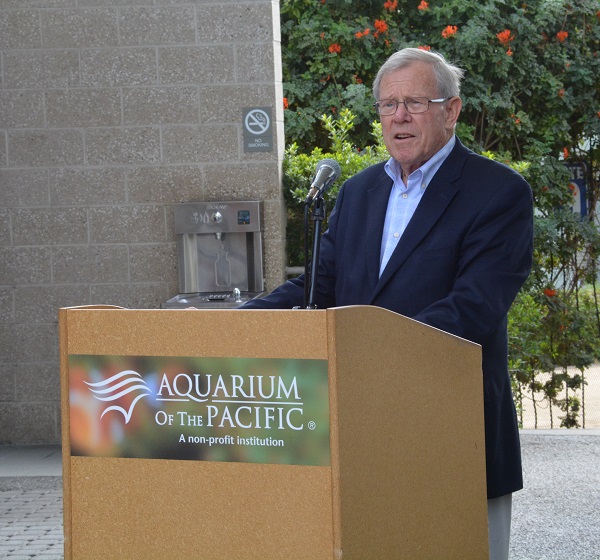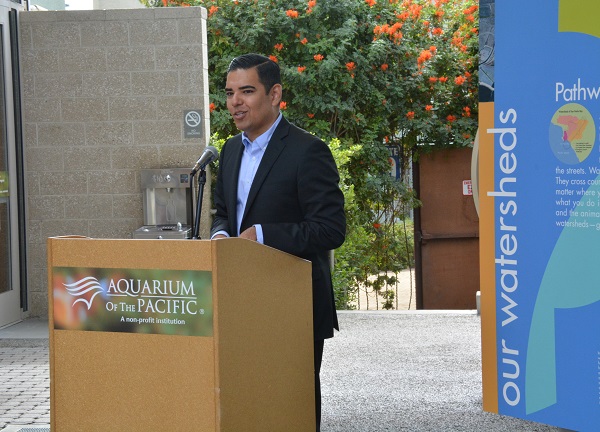by Dot Cannon
What is a “watershed”–and why is it essential?
On Tuesday morning, in Long Beach, the Aquarium of the Pacific unveiled the updated ways they’ll continue to answer those questions.
Prior to the presentation, we met a snake named Elvis.

“She’s a California king snake,” said Aquarium of the Pacific senior aviculturist Cara Templeton. King snakes, she explained, are nonpoisonous, but are immune to rattlesnake venom. Consequently, they can eat rattlesnakes!

“She’s a great addition to your back yard, if you have one.”
Elvis, who is fifteen years old, is a watershed animal: one that depends on the watershed for its health and survival. “Watersheds house and hide (animals like Elvis) from prey,” Templeton said. “Watersheds are integral for any animal that lives in Southern California.”
(And yes, Elvis is a female. Templeton explained that her gender was undetermined until she started laying eggs!)

Also in the Aquarium’s outdoor classroom area was senior aviculturist Susan Gerros, with Orion, an American kestrel. “He’s a non-releasable bird,” she said. “He was found near Palm Springs, with an injury consistent with being hit by a car.”

Orion, Gerros explained, has been at the Aquarium for nine and a half years. His left wing has a slight protrusion where his injury has healed.
Both Elvis and Orion are watershed animals. Consequently, they were on hand as Aquarium staff previewed their plans for updated watershed exhibits and educational programs. And preservation of local watersheds, which support their habitat, has a larger implication.
“(Protecting our local watersheds is) on the forefront, it has to be,” Gerros said. “We have to do due diligence across the boards.”

(As defined on the Aquarium’s website, a watershed is a piece of land that drains all its surface water, as well as the groundwater below, to the same place. Protection of the watershed is critical to any creatures dependent on a clean water supply for survival–including humans.)
During Tuesday’s presentation, the speakers discussed the ways education could help Californians deal with both the historic drought, and conditions yet to come.

“The California water story is a very important one to tell,” said Aquarium of the Pacific President and CEO Dr. Jerry Schubel. The Aquarium’s current watershed exhibit, he said, was constructed in 2008 and receives 1.6 million visitors a year. Now, the San Gabriel and Lower Los Angeles Rivers and Mountains Conservancy. which funded the original exhibit, has proposed an update.
“With RMC’s new support, we will be able to redesign the platform and support it,” Schubel said.
Long Beach Mayor Robert Garcia referenced the unusually-hot summer the city had experienced in 2016, predicting even higher temperatures in the future.

“Climate change is the issue of our time,” he said. “We’re able to renovate this entire exhibit to really understand (the watershed and water).”

Long Beach City Councilmember Jeannine Pearce said that the Aquarium had been the first to respond to the historic drought. “They cut water usage by one-third,” she commented. “This is obvious, that Long Beach would be a leader in conservancy.”

Next, San Gabriel and Lower Los Angeles Rivers and Mountains Conservancy Board Chair Frank Colonna talked about his organization’s mission, and how the renovated exhibit would support those goals.
“The Aquarium’s watershed exhibit helps visitors understand what happens on land, that affects our streams and oceans,” he said, before concluding his talk with John F. Kennedy’s 1962 quote about the sea:…”We are tied to the ocean. And when we go back to the sea,–whether it is to sail or to watch it–we are going back from whence we came.”
The moment had arrived.
Chairman Colonna and Mayor Garcia unveiled the plans for the updated exhibit area, scheduled to open in Spring, 2017.

Pointing out the different areas, Dr. Schubel told visitors that the renovations would include an interactive watershed map, showing the sources of California’s water and what’s happening with each source. He also said the exhibit would be much more interactive than at present.
“Kids will go to the watershed table where they can make it rain and splash all their friends and their parents,” he said.

“This is exciting, because this is going to teach kids and the next generation about the importance of conserving water…understanding the importance of the watershed,” Mayor Garcia commented, after the presentation. “So that’s very valuable, to make sure all those kids understand how important it is to protect the environment and create a sustainable city in the future.”
As a parent, Councilmember Pearce said, she’s seeing the effects of the Aquarium’s educational programs. “(This) is a great opportunity for our youth to play and learn, and take (that knowledge) home. My daughter never leaves the water on in between brushing her teeth because we came to places like this and did education.”

Among the educational exhibits in the new upgrade will be an exhibit that shows how to capture more of the rainfall into the groundwater, than at present.
“The problem right now is, that we’ve paved over so much of the landscape and water can’t percolate into the ground,” Dr. Schubel said. “So you can create settling basins or you can use (what) we have here. It’s called pervious concrete, so the water actually can seep through the concrete and into the ground.”
“I love this place, and I love coming to work every day,” he continued. “I think we have a wonderful staff. And the thing that makes us very different from most aquariums, is our willingness, not only to have great live-animal exhibits, but to tackle the big environmental issues that threaten their future, and that threaten ours….we embrace these complicated, controversial issues. “
